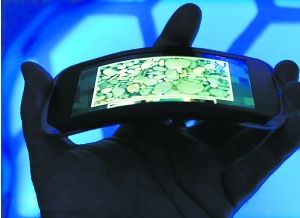"Magic Newspaper" or Coming Soon
Imagine a newspaper that looks and feels like real paper, but it can display dynamic content just like your smartphone or tablet. This is the "Magic Newspaper," a flexible screen that can be bent, folded, and even rolled up like a scroll. In the world of Harry Potter, there's a magical newspaper that updates itself in real-time, displaying news and images with a flick of a wand. Now, this fantasy might soon become a reality. The "Magic Newspaper" is a flexible screen that mimics the look and feel of traditional paper, making it easy to carry and use anywhere. Researchers have been working on flexible screens for years. In 2008, HP and the University of Arizona introduced a new technology called “Self-aligned imprinting lithography,†which allowed them to create consumer-grade flexible displays. These screens were made from plastic, not glass, making them lightweight, durable, and bendable. Two years later, HP showcased this innovation at a tech event in San Francisco, where the screen was as large as a newspaper but much more flexible. What made it truly impressive was its ability to function without losing quality, even when stretched or curved, and some models could even charge using solar power. Compared to today’s tablets, flexible screens are thinner, lighter, and free from fragile glass. This makes them not only more versatile but also more resilient. Companies like Apple, Nokia, and Sony are all investing heavily in this technology. Sony has already demonstrated a 13.3-inch foldable color e-paper screen, made from a special plastic material that feels almost like real paper. It's only 150 microns thick and weighs just 20 grams, offering a reading experience that's both modern and nostalgic. This year, many manufacturers are looking to bring flexible screens into everyday products. The first practical applications are likely to be in smaller devices like smartphones, followed by larger ones such as e-readers and tablets. As this technology becomes more widespread, the "Magic Newspaper" could revolutionize how we read, potentially replacing traditional printed media entirely. Mobile devices have become the main way people read digitally. A recent report shows that over 62% of users prefer reading on their phones, while 16% use e-readers and 12% opt for tablets. This trend highlights the growing reliance on mobile technology for daily reading habits. Digital reading is no longer a niche activity—it’s becoming a lifestyle. According to a study, 77% of Chinese digital readers are willing to pay for high-quality content, showing that the market is maturing. With more platforms offering books, articles, and magazines, the ecosystem for digital reading is expanding rapidly. As software and hardware continue to merge, the future of reading is getting more seamless. E-readers like Bambook are gaining popularity, offering an optimized experience for long reading sessions. Unlike tablets, which are often used for gaming, or smartphones, which are mainly for communication, these devices are built specifically for reading. The "Magic Newspaper" isn’t just a concept—it’s a glimpse into the future of information consumption. With ongoing advancements in flexible screen technology, it's only a matter of time before we see this vision come to life. Compensation Resistors Gauges,Temperature Compensated Strain Gauge,32Ohm Temperature Compensated Strain Gauge,95Ohm Temperature Compensated Strain Gauge Zhejiang Nanhua Electronic Technology Co., Ltd , https://www.nhloadcell.com

The prototype of this futuristic device is set to appear on mobile phones soon, bringing the concept of digital newspapers closer to reality.